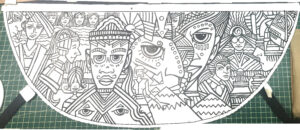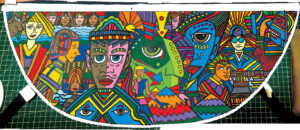This week I continued to work on the painting on the cape of my new coat. The coat is a western duster which is the only type of coat I know of that comes with a small cape. It takes a lot of work to paint on a coat. Luckily the cape comes off the coat. That makes it a lot easier to work on.
Last I wrote I had transferred the drawing onto the cape and was ready to “Ink” the drawing. I put ink in quotes because I didn’t actually use ink. Instead I used black fabric paint. Ink would have been easier. At least ink on paper would have been easier.
The end result is about the same as I’m redrawing the pencil drawing with a black line but fabric paint on canvas is a tougher task than ink on paper. Fabric paint is thicker than ink and the canvas material of the coat is a lot rougher than paper.
I used the same type of painted watercolor brush to make the black line but since paint doesn’t flow as well as ink I had to make shorter lines before putting more paint on the brush. It’s a much more tedious process but the paint line isn’t going to be the final line so it doesn’t have to be perfect just yet.
After I put down the black line then I’ll fill in between the lines with color paint, Then I’ll redo the black line to a finish. The “Fill in between the lines with paint” part sounds easier than what it will be because I won’t just be filling in. I’ll be painting the images at that point in some style that I have yet to determine. It’ll take a while.
What I did yesterday was to make a digital color sketch. I took a photo of the black and white drawing on the cape, brought the drawing into Photoshop, and then colored the drawing. This is a really complicated drawing and it took me about six hours to do the color sketch. Since I’ll be wearing this painting for who knows how many years there was no reason to rush through the color sketch. I took my time and contemplated what each area of the drawing should be. That was not easy with so many shapes and colors.
At first I tried to make the color sketch on my iPad with Procreate. It’s not hard to do on that app but I started growing frustrated that the screen was too small and it was clumsy to make such a complicated color sketch on such a small screen. That’s when I decided to switch over to Photoshop and my 27 inch monitor. Plus I have a lot more experience with Photoshop than with Procreate. It ended up being the correct decision since all my frustration disappeared.
I also have my swatches in Photoshop. Those are a palette full of the colors that I use all the time. They’re like a set of paints. I’m so used to working with those colors that it’s second nature to me at this point. I’ve even transferred those same color swatches over to Procreate but somehow it’s different. They’re literally different in that all the colors are in one palette in Photoshop but take up three separate palettes in Procreate. That makes them harder for me to work with. Or at least I’m less used to working with them that way.
After I had the color sketch done in Photoshop I tried something new. In order to prepare the cape for painting I first primed it with opaque white fabric paint. I bought a set of fabric paints that came with a regular white paint but I bought this bottle of opaque white special just to prime the cape with. Since the cape was black I knew that the fabric paints would have a hard time covering up the black on their own so that priming the cape with opaque white would help me when I started laying down the color. As a consequence I had a black line painting on a white ground. But I didn’t keep it white.
I thought I could make the whole process easier for myself if I could transfer my color sketch on the cape. So I got the idea to use my Copic markers to draw on the white parts of the cape. It would almost turn it into a paint by numbers painting.
I’m going to have to mix some colors out of the fabric paint. I bought a set of eight colors of what appears to be good fabric paint but then I bought a second set of eighteen colors of cheaper fabric paint. I don’t know if the cheaper paint is really any worse for my use but they’ll help me get the exact colors that I want.
Meanwhile I took a couple of hours and transferred the color onto the cape with markers. It was nothing fancy. I just had to pay attention to my digital sketch, chose markers of a similar color, and then fill in the appropriate area on the painting with that color. The color looks thin and transparent but it is getting painted over anyway.
I think I’ll be able to mix a color with the fabric paint and apply it to the cape faster than if I have to look over at the color sketch on the computer monitor and follow along with that. Plus with the marker color I can see if the colors work well with each other in a real space rather than a digital one.
I’m happy now that the black line is painted on and the color sketch is applied to the cape. Now the painting can really begin. All the previous stuff is preliminary work that has to be done but maybe isn’t as creatively satisfying. Of course along with the more creative work comes having to figure out what style I want to finish the piece in. I’m still not a hundred percent sure about that. But I have time to figure it out. Even though I’ve got a lot done so far there is still a long way to go to finish this painting.

